Table of contents
- Guide: Injection on a motorcycle Find and rectify faults in the injection system
- More about technology
- Workshop guide part 2: troubleshooting
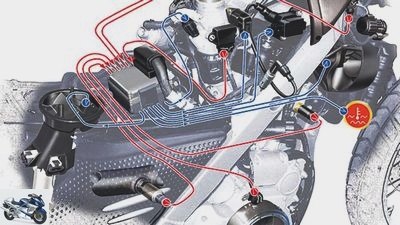
Drawing: Schermer
counselor
technology & future
Guide: Injection on a motorcycle
Guide: Injection on a motorcycle
Find and rectify faults in the injection system
What to do if the engine coughs, spits and all the warning lights in the cockpit turn off? Then there is usually a problem with the injection system. Tips for troubleshooting and troubleshooting without a diagnostic device.
Jorg Lohse
02/04/2010
Fault in the injection: This engine problem can hardly be pinpointed with the usual household remedies of a garage wrench in modern motorcycles; because the engine electronics are networked with a large number of sensors that influence mixture preparation and combustion. Here is a brief overview of the sensors and their function:
Buy complete article

Guide: Injection on a motorcycle
Find and rectify faults in the injection system
2 pages) as PDF
€ 2.00
Buy now
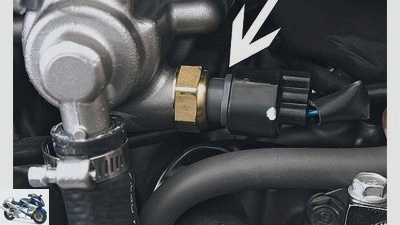
Schermer
Coolant temperature sensor: Ensures that the mixture is enriched when the engine is cold.
SENSORS
- The throttle valve potentiometer is attached directly to the throttle valve housing. It determines the position of the throttle grip and thus the position of the throttle valves: the further they are open, the more fuel is required, and the ignition timing is also influenced by it.
- The coolant temperature sensor is built into the cooling circuit; it measures the current temperature of the engine coolant: the cooler the engine, the more fuel it needs. During a cold start z. B. properly “fat”.
- The ambient air pressure sensor is on one “calmed place” installed on the vehicle (e.g. under the rear panel) and measures the current ambient air pressure. The basic air pressure programmed in the engine control unit relates to “Sea level zero”. In higher regions, the air pressure drops, and the need for fuel is correspondingly lower. Then, however, the engine output also drops.
- The intake air temperature sensor is built into the air filter box. Basic rule: the colder the intake air, the higher the fuel requirement; the warmer the intake air, the less fuel is required.
- The crankshaft position sensor checks the position of the crankshaft and is generally positioned at the bottom right or left of the crankshaft stub. It acts as an ignition transmitter and causes the mixture to be ignited when the crankshaft is in the appropriate position. At the same time, it measures the engine speed.
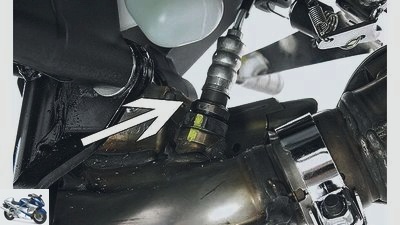
Schermer
Lambda probe: Measures the residual oxygen content of the exhaust gas and corrects the mixture composition.
- The camshaft position sensor monitors the position of the camshaft and works in combination with the crankshaft position sensor: It determines which cylinder is injected and which is ignited.
- The speed sensor is positioned either directly on a wheel or on the transmission output shaft next to the front chain sprocket. It is a speed sensor, from the data of which the current speed is calculated. This data is not only forwarded to the speedometer display. In conjunction with the current throttle grip position and the gear engaged, they also determine the injection quantity and the ignition point.
- The lambda probe measures the residual oxygen content in the exhaust gas and, if necessary, corrects the mixture composition (injection quantity) according to the current value.
More about technology
PS knowledge: technology
- Motorcycle technology clearly explained on 97 pages (PDF)
- From starter to spark plug
- Simple teaching of physical principles
- Tips and tricks for practitioners
To the PDF for € 9.99
#image.jpg

Schermer
Motor control: control center in which all threads come together. Switches to an emergency program in the event of problems.
CONTROL UNIT
The values recorded by the sensors are sent to the engine control unit. Characteristic maps and correction functions are stored in this. From the mixture of all data, individually coordinated values for the injection quantity and ignition point of each cylinder for the respective work cycle are determined.
Fuel cut-off
In most cases, an overrun fuel cut-off is also programmed: When the throttle valves are closed (“Gas too”), an engine temperature of around 20 degrees Celsius and an engine speed of more than 3000 rpm, activation of the injection valves is interrupted. This lowers consumption and prevents z. B. when driving downhill that the engine gets fuel despite the throttle grip closed, this is ignited and as a result “pushes”. If the engine speed falls below 2500 rpm, injection is reactivated.
Other functions of the engine electronics include self-diagnosis and checking that the injection and ignition are working properly. It is constantly checking itself. Depending on the manufacturer, malfunctions are displayed differently in the cockpit: Either by flashing signals from a control lamp, in LCD cockpits also by displaying an error code. In general, this means: Off to the workshop, because the faults can only be read out and the defective component localized using the manufacturer’s diagnostic device.
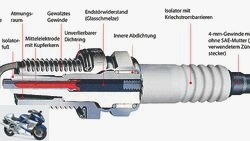
technology & future
Adviser: change spark plugs
Everything about spark plugs
read more
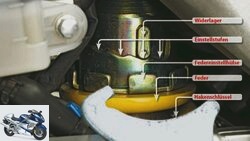
workshop
Advice: adjust springs and dampers
Tips for adjusting the suspension and damping
read more
Workshop guide part 2: troubleshooting
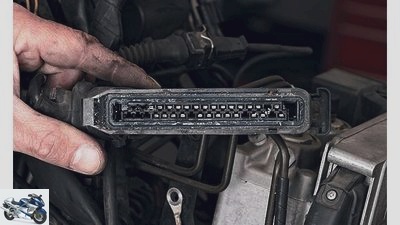
Schermer
Connector check: corroded or incorrectly mated connections can be a source of errors.
Possible malfunctions, troubleshooting
If, with a corresponding message in the cockpit, a malfunction occurs with the injection, do not switch off the engine, but let it run; because in the event of almost all malfunctions, the engine electronics switch to an emergency running program, with which it is possible to continue driving. The engine is only switched off automatically in the event of faults in the injection valves, the ignition pulse generator, failure of the engine control unit or a fuse defect. If no authorized dealer can be reached, first look for errors in the on-board electrical system and in the supply lines:
- Check all possible plugs to ensure that they are correctly connected.
- Pull apart one connector after the other, clean the inner contacts with a hard toothbrush and contact spray, blow out and check for tightness.
- Check all hoses and lines in question for breaks, kinks, crushing or other damage! If even one of the gasoline or air hoses is squashed or torn, or does not sit properly on its socket, this has a negative impact on the entire intake and injection system.
- Check fuses for injection and ignition. Where the fuses can be found on your machine and what strengths (amperes) they have is stated in the log book belonging to the machine (operating manual).
Dirt in the injection
If the engine is guaranteed to be OK, but does not run properly on one (or more) cylinder (s), there is a strong suspicion that there is dirt in the gasoline. Then sometimes it helps to drain the dirty gasoline and fill it up with fresh fuel. And please: Do not smoke when handling fuel, wear protective gloves, avoid inhaling fuel vapors if possible and dispose of old gasoline in an environmentally friendly manner!
It can happen that the inside of the throttle valve body is dirty or that individual air ducts are blocked. Especially if the motorcycle has been idle for a long time. In such cases, the entire throttle valve housing must be dismantled and cleaned in an ultrasonic bath. Every well-established dealer has such a device; Intensive cleaning in the ultrasonic bath costs money (up to 250 euros, depending on the degree of soiling), but it works wonders.
Important: NEVER insert hard steel wires into holes that appear to be dirty or actually blocked!
It is usually unavoidable to take the motorcycle to the dealer and use the diagnostic device to troubleshoot. In addition, the mechanics in the authorized workshops either in the factory (e.g. at BMW) or by the importers have been specially trained to deal with injection problems. In addition, they have quick access to the latest measurement technology and can therefore quickly isolate a possible fault and replace the defective component.
Related articles
-
Technology: injection electronics
K counselor technology & future Technology: injection electronics Technology: injection electronics What’s humming there?? Content of When five-year-olds…
-
Guide to cornering a motorcycle
Jkuenstle.de counselor workshop Guide to cornering a motorcycle Cornering Part 2: Creating smooth transitions Drive properly through the curves Cornering…
-
Guide to changing the brake pads on the motorcycle
Ralf Schneider counselor workshop Guide to changing the brake pads on the motorcycle Change the brake pads on the motorcycle Tips from professionals…
-
New Bosch motorcycle safety systems
Bosch 17th pictures Bosch 1/17 To make motorcycling even safer, Bosch is developing numerous new assistance systems. Bosch 2/17 Motorcycles should learn…
-
MOTORCYCLE screwdriver tip on starting problems
Ralf Petersen 19th pictures Ralf Petersen 1/19 Starting problems on the motorcycle are tricky. They can occur without warning, whether the engine is cold…
-
Photo: Rossen Gargolov 9 pictures Artist 1/9 While the machine is being cleaned, it can be checked for defects at the same time. Herder 2/9 Let the chain…
-
Buying a used Harley-Davidson motorcycle guide
Bilski counselor Used purchase Buying a used Harley-Davidson motorcycle guide Buying a used Harley-Davidson motorcycle guide How to expose second-hand…
-
Motorcycle transport solutions Caravans, mobile homes, trailers, transport systems Herder to travel Motorcycle transport guide Motorcycle transport guide…
-
Guide to repairing spoked motorcycle wheels Part 1
Marcel Schoch 38 pictures Marcel Schoch 1/38 Preparatory work: The bike must always be removed for repairs. Damage to the tire can be an indication that…
-
Fox counselor traffic & business Motorcycle financing guide Motorcycle financing guide Buy on credit If you want to buy a motorcycle, you can choose…